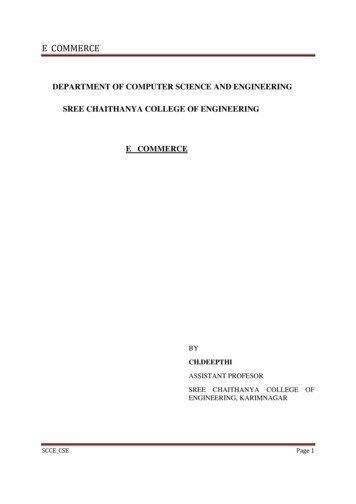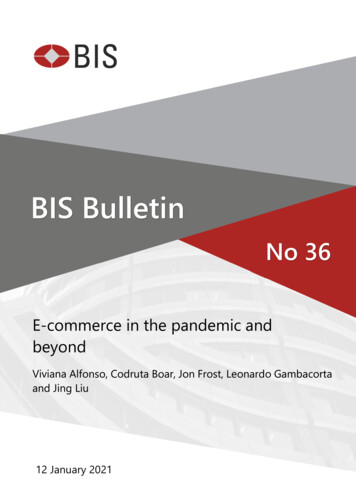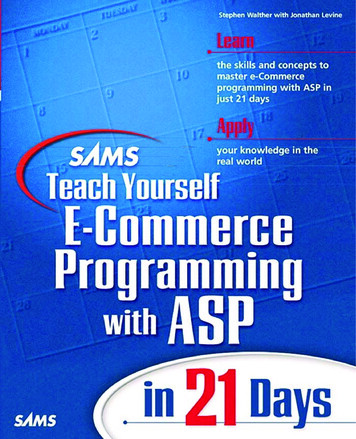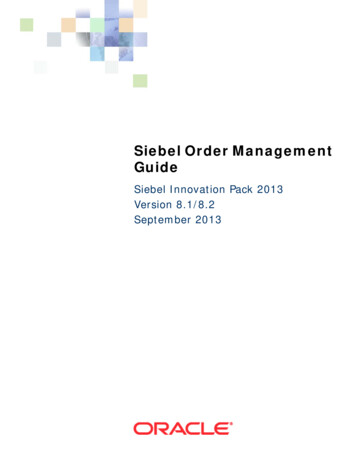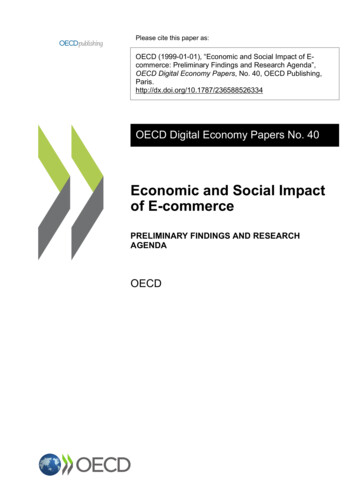
Transcription
Please cite this paper as:OECD (1999-01-01), “Economic and Social Impact of Ecommerce: Preliminary Findings and Research Agenda”,OECD Digital Economy Papers, No. 40, OECD 26334OECD Digital Economy Papers No. 40Economic and Social Impactof E-commercePRELIMINARY FINDINGS AND RESEARCHAGENDAOECD
The full impact of e-commerce remains to be seen. This book begins toaddress these questions and provides a ground-breaking assessment of theeconomic and social impacts of electronic commerce and its effects on jobs bydrawing on existing qualitative and quantitative evidence. This early analysis ofan extremely dynamic activity identifies a number of areas where research isurgently needed and serves as the basis for an informed policy debate.9:HSTCQE V[ \WW:OECD(93 1999 01 1 P) FF 135ISBN 92-64-16972-599ORGANISATION FOR ECONOMIC CO-OPERATION AND DEVELOPMENTThe changes e-commerce will bring are far-reaching. They require newframeworks for doing business and a re-examination of government policiesrelating to commerce and skills. What is electronic commerce? What is thecurrent state and likely future direction of e-commerce? What are the drivers andwhat are the inhibitors? What is its impact on costs, prices, and ultimately oneconomic efficiency? How is it affecting intermediaries? How do firms competein the electronic environment? What market structure is likely to emerge? Whatis the impact on jobs? What types of skills will be needed? What major societaltransformations will it entail?The Economic and Social Impact of Electronic CommerceThough only three years old, electronic commerce over the Internet has thepotential to transform the marketplace. E-commerce will change the waybusiness is conducted. Traditional intermediary functions will be replaced, newproducts and markets will be developed, and new relationships will be createdbetween business and consumers. It will alter the way work is organised andopen new channels of knowledge diffusion and human interactivity in theworkplace. Workers will need to be more flexible as their functions and skills areredefined.The EconomicandSocial Impactof ElectronicCommercePreliminary Findingsand Research Agenda
00 Foreword.fm Page 1 Thursday, January 28, 1999 12:28 PMTHE ECONOMICAND SOCIAL IMPACTOF ELECTRONICCOMMERCEPreliminary Findingsand Research AgendaORGANISATION FOR ECONOMIC CO-OPERATION AND DEVELOPMENT
00 Foreword.fm Page 2 Thursday, January 28, 1999 12:28 PMORGANISATION FOR ECONOMIC CO-OPERATIONAND DEVELOPMENTPursuant to Article 1 of the Convention signed in Paris on 14th December 1960, and which came into forceon 30th September 1961, the Organisation for Economic Co-operation and Development (OECD) shall promotepolicies designed:– to achieve the highest sustainable economic growth and employment and a rising standard of living inMember countries, while maintaining financial stability, and thus to contribute to the development of theworld economy;– to contribute to sound economic expansion in Member as well as non-member countries in the process ofeconomic development; and– to contribute to the expansion of world trade on a multilateral, non-discriminatory basis in accordancewith international obligations.The original Member countries of the OECD are Austria, Belgium, Canada, Denmark, France, Germany,Greece, Iceland, Ireland, Italy, Luxembourg, the Netherlands, Norway, Portugal, Spain, Sweden, Switzerland,Turkey, the United Kingdom and the United States. The following countries became Members subsequentlythrough accession at the dates indicated hereafter: Japan (28th April 1964), Finland (28th January 1969),Australia (7th June 1971), New Zealand (29th May 1973), Mexico (18th May 1994), the Czech Republic(21st December 1995), Hungary (7th May 1996), Poland (22nd November 1996) and Korea (12th December 1996). The Commission of the European Communities takes part in the work of the OECD (Article 13 of theOECD Convention).Publié en français sous le titre :LES INCIDENCES ÉCONOMIQUES ET SOCIALES DU COMMERCE ÉLECTRONIQUE OECD 1999Permission to reproduce a portion of this work for non-commercial purposes or classroom use should be obtained through theCentre français d’exploitation du droit de copie (CFC), 20, rue des Grands-Augustins, 75006 Paris, France,Tel. (33-1) 44 07 47 70, Fax (33-1) 46 34 67 19, for every country except the United States. In the United States permissionshould be obtained through the Copyright Clearance Center, Customer Service, (508)750-8400, 222 Rosewood Drive,Danvers, MA 01923 USA, or CCC Online: http://www.copyright.com/. All other applications for permission to reproduce ortranslate all or part of this book should be made to OECD Publications, 2, rue André-Pascal, 75775 Paris Cedex 16, France.
00 Foreword.fm Page 3 Thursday, January 28, 1999 12:28 PMForewordThis book was prepared as a background document for the OECD Ministerial Conference on“A Borderless World: Realising the Potential of Global Electronic Commerce”, held in Ottawa, Canada, inOctober 1998. It represents one of the very first analyses of the role of electronic commerce in the broadereconomy, and addresses such issues as the impact of e-commerce on employment and on society as awhole, as well as its contribution to economic growth and efficiency. The book presents a significantamount of data to provide policy makers with a picture of the current state and likely future direction ofelectronic commerce. The preliminary findings and broad policy implications constitute an initial analytical basis for understanding electronic commerce, how it may evolve and how it may transform oureconomies and societies. As with any analytical report which examines a phenomenon as young and complex as electronic commerce, it generates as many questions as it answers. These questions form thebasis of a potential future research agenda which is outlined in the book. The book is divided into chapters organised according to major areas of impact – economic growth, economic efficiency, organisationalchange, employment, and broader social issues.The OECD has been studying issues associated with the “Information Society” for nearly twodecades. This book builds on that work, but represents a significant departure from those earlier studiesas the focus has broadened to embrace an economy-wide perspective. To support this extension,advisory groups were created, and the book has benefited from significant review, both internally withinthe OECD, in Member countries, and from a group of private experts who attended a workshop where thebook was discussed (Ottawa, 28-30 June 1998). In particular, the OECD would like to thank the followingexperts for their valuable contributions:Dr. Richard HawkinsFellow – Information,Networks & Knowledge (INK)Science Policy Research Unit (SPRU)University of Sussex, United KingdomLynn MargherioBusiness strategy consultant, United StatesJohan HelsingiusDirector of Product Developmentand MarketingEUnet International BVProfessor Dr. Luc L.G. SoeteDirector MERIT, Faculty of Economicsand Business AdministrationUniversity of Maastricht, The NetherlandsProf. Jiro KokuryoAssociate ProfessorKeio University Graduate School of BusinessAdministration, JapanPhilip SwanDirector of EconomicsIBM Corporation, United StatesMichael McCrackenChairman and CEOInformetrica Limited, CanadaProf. Robin MansellDirector – Information,Networks & Knowledge (INK)Science Policy Research Unit (SPRU)University of Sussex, United Kingdom3
00 Foreword.fm Page 4 Thursday, January 28, 1999 12:28 PMThe Economic and Social Impact of Electronic CommerceThe book, written by Andrew Wyckoff and Alessandra Colecchia of the Information, Computer andCommunications Policy Division at the OECD, has also benefited from both substantive and financial contributions made by the Government of Canada. Canada’s Electronic Commerce Task Force assisted in thedrafting of some portions, particularly the chapter on the societal implications, hosted and financed theworkshop where the book was discussed, and provided the French translation. The OECD would like toexpress its appreciation to Richard Simpson, Director General for Policy Coordination, and his team fortheir efforts in support of this work. At the OECD, substantive contributions by Anthony Rottier of theSecretary-General’s Private Office, Dirk Pilat of the Science and Technology Policy Division,Muriel Faverie, consultant, Doranne Lecercle for the editing, and Pierre Montagnier for statistical assistance, are gratefully acknowledged.Nevertheless, none of these individuals or organisations are accountable for the findings andconclusions of the book.The book is published on my responsibility as Secretary-General of the OECD.4
00 Foreword.fm Page 5 Thursday, January 28, 1999 12:28 PMTable of contentsExecutive summary . . . . . . . . . . . . . . . . . . . . . . . . . . . . . . . . . . . . . . . . . . . . . . . . . . . . . . . . . . . . . . . . . . .9Chapter 1.Growth of electronic commerce: present and potential . . . . . . . . . . . . . . . . . . . . . . . . . .27Chapter 2.The impact of electronic commerce on the efficiency of the economy . . . . . . . . . . . . .55Chapter 3.The impact of electronic commerce on firms’ business models,sectoral organisation and market structure79Chapter 4.Electronic commerce, jobs and skills . . . . . . . . . . . . . . . . . . . . . . . . . . . . . . . . . . . . . . . . .105Chapter 5.Societal implications of electronic commerce . . . . . . . . . . . . . . . . . . . . . . . . . . . . . . . . . .143.157ReferencesList of tables1.2.3.Estimates of e-commerce sales compared to various benchmarks . . . . . . . . . . . . . . . . . .E-commerce impact on various distribution costs . . . . . . . . . . . . . . . . . . . . . . . . . . . . . . . .IT jobs unfilled owing to skill shortages . . . . . . . . . . . . . . . . . . . . . . . . . . . . . . . . . . . . . . . . sons of various total e-commerce estimates . . . . . . . . . . . . . . . . . . . . . . . . . . . . . .Selected individual firm e-commerce revenues by activity . . . . . . . . . . . . . . . . . . . . . . . .Estimates of e-commerce sales compared to various benchmarks . . . . . . . . . . . . . . . . . .Geographic breakdown of e-commerce, various years . . . . . . . . . . . . . . . . . . . . . . . . . . . . .Comparison of various e-commerce estimates by country . . . . . . . . . . . . . . . . . . . . . . . . .Location of top 100 WWW sites by category, June 1997 . . . . . . . . . . . . . . . . . . . . . . . . . . . .E-commerce broken down into major segments and products . . . . . . . . . . . . . . . . . . . . . .E-commerce estimated to be business-to-business . . . . . . . . . . . . . . . . . . . . . . . . . . . . . .Top 10 retail shopping sites based on usage, February 1997 . . . . . . . . . . . . . . . . . . . . . . .2730303233333536392.1.2.2.2.3.2.4.2.5.2.6.OECD trends in collection charges . . . . . . . . . . . . . . . . . . . . . . . . . . . . . . . . . . . . . . . . . . . . .Deployment of fibre optic cable in the OECD area . . . . . . . . . . . . . . . . . . . . . . . . . . . . . . .Cisco’s e-commerce customer support cost savings . . . . . . . . . . . . . . . . . . . . . . . . . . . . . . .E-commerce impact on various distribution costs . . . . . . . . . . . . . . . . . . . . . . . . . . . . . . . .Distribution margins for goods, selected OECD countries . . . . . . . . . . . . . . . . . . . . . . . . . .Input-output commodity composition of personal consumptionexpenditures (PCE) in producers’ and purchasers’ prices, 1992 . . . . . . . . . . . . . . . . . . . . .Impact of e-commerce on commissions . . . . . . . . . . . . . . . . . . . . . . . . . . . . . . . . . . . . . . . . .America Online’s deals, 1997-98 . . . . . . . . . . . . . . . . . . . . . . . . . . . . . . . . . . . . . . . . . . . . . . .Does the move to electronic markets increase the importanceof these intermediation services? . . . . . . . . . . . . . . . . . . . . . . . . . . . . . . . . . . . . . . . . . . . . . .A survey of studies analysing the impact of e-commerce on prices . . . . . . . . . . . . . . . . . .59606163652.7.2.8.2.9.2.10.66686971735
00 Foreword.fm Page 6 Thursday, January 28, 1999 12:28 PMThe Economic and Social Impact of Electronic Commerce3.1.3.2.3.3.3.4.E-commerce firms’ presence on international markets . . . . . . . . . . . . . . . . . . . . . . . . . . . . .Online revenues: percentage share of international markets . . . . . . . . . . . . . . . . . . . . . . . .Net revenues/sales and operating and development expenditures for e-commerce firmsRevenues and R&D for manufacturers of Internet equipment . . . . . . . . . . . . . . . . . . . . . . .4.1.4.6.4.7.4.8.Contribution of selected industries to average annualemployment growth rate, United States and EU-10 . . . . . . . . . . . . . . . . . . . . . . . . . . . . . . . .Heterogeneity in e-commerce-related sectors . . . . . . . . . . . . . . . . . . . . . . . . . . . . . . . . . . . .Estimated e-commerce full-time employees in selected US firms . . . . . . . . . . . . . . . . . . .Employment in selected e-commerce-related US industries: estimates and projectionsVirtual/conventional forms of organisation: some examplesof productivity and profitability . . . . . . . . . . . . . . . . . . . . . . . . . . . . . . . . . . . . . . . . . . . . . . . .Indicators of network banking: Finland and EU, 1994 . . . . . . . . . . . . . . . . . . . . . . . . . . . . . .The work force in e-commerce-related companies: content aggregation . . . . . . . . . . . . . .Occupational categories used in the EU-US comparisons . . . . . . . . . . . . . . . . . . . . . . . . . . .5.1.Technology penetration rates and income levels on Canadian households, 1996 . . . . . 50List of figures1.2.6Growth in Internet host computers and major e-commerce developments . . . . . . . . . . . .Computer penetration rates, by household income, in Australia,Canada, Japan and the United States9191.1.1.2.1.3.Adults accessing the Internet, selected OECD countries . . . . . . . . . . . . . . . . . . . . . . . . . . .US ICT industry share of GDP and contribution to growth . . . . . . . . . . . . . . . . . . . . . . . . . .Impact of e-commerce on a product basis, 2000-05 . . . . . . . . . . . . . . . . . . . . . . . . . . . . . . . .3436442.1.2.2.2.3.2.4.2.5.World-wide memory chip and semiconductor price indices . . . . . . . . . . . . . . . . . . . . . . . . .US disk drives, printers and other peripherals price indices . . . . . . . . . . . . . . . . . . . . . . . .US mainframes and personal computers price indices . . . . . . . . . . . . . . . . . . . . . . . . . . . . .Cable cost per voice path, 1974-97 . . . . . . . . . . . . . . . . . . . . . . . . . . . . . . . . . . . . . . . . . . . . . .Impact of US industry on inflation . . . . . . . . . . . . . . . . . . . . . . . . . . . . . . . . . . . . . . . . . . . . . loyment trends in the US Post Office . . . . . . . . . . . . . . . . . . . . . . . . . . . . . . . . . . . . . . . .US retail trade employment, 1983-2006 . . . . . . . . . . . . . . . . . . . . . . . . . . . . . . . . . . . . . . . . . .Finnish bank employment and transactions, 1984-96 . . . . . . . . . . . . . . . . . . . . . . . . . . . . . .US banking sector employment, 1983-2006 . . . . . . . . . . . . . . . . . . . . . . . . . . . . . . . . . . . . . . .Skill shares within selected sectors, EU-10, 1996 . . . . . . . . . . . . . . . . . . . . . . . . . . . . . . . . . .Average annual growth rates in selected occupations, EU-10 and United States, 1993-97Share of e-commerce-related occupations within the US economy, 1983-95 . . . . . . . . . . .Share of ICT-related occupations in the United States and the OECD, 1983-2006 . . . . . .Share of ICT-related occupations within the US economy, 1983-2006 . . . . . . . . . . . . . . . . .1131131141151221241251251265.1.Computer penetration rates, by household income, in Australia,Canada, Japan and the United States . . . . . . . . . . . . . . . . . . . . . . . . . . . . . . . . . . . . . . . . . . . .150
00 Foreword.fm Page 7 Thursday, January 28, 1999 12:28 PMTable of contentsList of boxes1.11.21.31.4Defining electronic commerce . . . . . . . . . . . . . . . . . . . . . . . . . . . . . . . . . . . . . . . . . . . . . . . . . .Data and measurement issues for e-commerce . . . . . . . . . . . . . . . . . . . . . . . . . . . . . . . . . . .Recent efforts by national statistical offices . . . . . . . . . . . . . . . . . . . . . . . . . . . . . . . . . . . . . .Predictions of near-term growth in selected e-commerce sectors . . . . . . . . . . . . . . . . . . . .283132422.12.2Dell, e-commerce and inventories . . . . . . . . . . . . . . . . . . . . . . . . . . . . . . . . . . . . . . . . . . . . . .Network-based intermediaries . . . . . . . . . . . . . . . . . . . . . . . . . . . . . . . . . . . . . . . . . . . . . . . . .62693.13.23.33.4Cyber-traders . . . . . . . . . . . . . . . . . . . . . . . . . . . . . . . . . . . . . . . . . . . . . . . . . . . . . . . . . . . . . . . .Pirating the value chain: the case of the personal computer industry . . . . . . . . . . . . . . . . .Path dependencies . . . . . . . . . . . . . . . . . . . . . . . . . . . . . . . . . . . . . . . . . . . . . . . . . . . . . . . . . . .Changes in innovation and technology diffusion processes:the role of ICTs and organisational change . . . . . . . . . . . . . . . . . . . . . . . . . . . . . . . . . . . . . . .8082884.14.24.34.44.5Job losses and gains at CIBC (Canada) . . . . . . . . . . . . . . . . . . . . . . . . . . . . . . . . . . . . . . . . . . .Learning from the Minitel experience? . . . . . . . . . . . . . . . . . . . . . . . . . . . . . . . . . . . . . . . . . .Skill needs in Internet-/intranet-related European companies . . . . . . . . . . . . . . . . . . . . . .Ten new e-commerce jobs . . . . . . . . . . . . . . . . . . . . . . . . . . . . . . . . . . . . . . . . . . . . . . . . . . . . .Selected occupations affected by e-commerce . . . . . . . . . . . . . . . . . . . . . . . . . . . . . . . . . . .1 161161201211235.1Examples of competitive advantages from teleworking . . . . . . . . . . . . . . . . . . . . . . . . . . . .152917
00 Foreword.fm Page 8 Thursday, January 28, 1999 12:28 PM
01 Summary.fm Page 9 Thursday, January 28, 1999 11:24 AMEXECUTIVE SUMMARYIntroductionElectronic commerce over the Internet is a new way of conductingbusiness. Though only three years old, it has the potential to radically alter economic activities and the social environment. Already,it affects such large sectors as communications, finance and retailtrade (altogether, about 30 per cent of GDP). It holds promise inareas such as education, health and government (about 20 per centof GDP). The largest effects may be associated not with many of theimpacts that command the most attention (e.g. customised products,the elimination of middlemen) but with less visible, but potentiallymore pervasive, effects on routine business activities (e.g. orderingoffice supplies, paying bills, and estimating demand), that is, on theway businesses interact.1Figure 1 .Electronic commerce has the potentialto radically alter some economicactivities and the surrounding socialenvironment.Growth in Internet host computers a nd ma jor e-commerce dev elopmentsFigure 1.Growth in Internet host computers and major e-commerce developmentsNumber of hosts (log scale)100 000 000Number of hosts (log scale)100 000 0001994:Netscape releasesNavigator browser1991:NSF lifts restrictionson commercial useof Internet10 000 0001969:Internet/ARPAnet1989:WWW HTMLlanguage inventedat CERN1 000 00010 000 0001995:Dell, Cisco and Amazonbegin to aggressively useInternet for commercialtransactions100 0001 000 000100 0001993:Mosaic browserinvented at University of Illinoisis released to public10 00010 0001 0001 0001001001982838485* New methodology used in January 1998.Source: Network Wizards.868788899091January of each year92939495969798*9
01 Summary.fm Page 10 Thursday, January 28, 1999 11:24 AMThe Economic and Social Impact of Electronic CommerceIt emerged in the wake of regulatoryreform and various technologicalinnovations.A combination of regulatory reform and technological innovationenabled e-commerce to evolve as it has. Although the precursor ofthe Internet appeared in the late 1960s, Internet e-commerce tookoff with the arrival of the World Wide Web and browsers in the early1990s and the liberalisation of the telecommunications sector andinnovations that greatly expanded the volume and capacity of communications (optic fibre, digital subscriber line technologies, satellites). and barriers to entry have fallen.As a result, barriers to engage in electronic commerce have progressively fallen for both buyers and sellers. Earlier forms of e-commercewere mostly custom-made, complex, expensive and the province oflarge firms. Today, for a few thousand dollars, anyone can become amerchant and reach millions of consumers world-wide. What used tobe business-to-business transactions between known parties hasbecome a complex web of commercial activities which can involvevast numbers of individuals who may never meet. In this sense, theInternet has done for electronic commerce what Henry Ford did forthe automobile – converted a luxury for the few into a relatively simple and inexpensive device for the many.It is important to begin to explore theseimpacts and provide some analyticalfoundation for further work.This book begins to explore these impacts and provides a preliminary analytical foundation for further work. It does not present anexhaustive analysis – it is too early for that – but musters as muchinformation as possible so as to provide policy makers with a quantitative picture, albeit blurry, of the current state and likely futuredirection of electronic commerce. On this basis, policy makers canbegin to outline the parameters of its impact and identify areas inneed of future research.Economic drivers of e-commerceFive broad themes have emerged as important for understandingthe economic and social impact of electronic commerce:10The effect on the marketplace.Electronic commerce transforms the marketplace. E-commerce will changethe way business is conducted: traditional intermediary functionswill be replaced, new products and markets will be developed, newand far closer relationships will be created between business andconsumers. It will change the organisation of work: new channels ofknowledge diffusion and human interactivity in the workplace willbe opened, more flexibility and adaptability will be needed, andworkers’ functions and skills will be redefined. the catalytic role.Electronic commerce has a catalytic effect. E-commerce will serve to accelerate and diffuse more widely changes that are already under way inthe economy, such as the reform of regulations, the establishment ofelectronic links between businesses (EDI), the globalisation of economic activity, and the demand for higher-skilled workers. Likewise,many sectoral trends already under way, such as electronic banking,direct booking of travel, and one-to-one marketing, will be accelerated because of electronic commerce. the impact on interactivity.E-commerce over the Internet vastly increases interactivity in the economy. Theselinkages now extend down to small businesses and households andreach out to the world at large. Access will shift away from relatively
01 Summary.fm Page 11 Thursday, January 28, 1999 11:24 AMExecutive Summaryexpensive personal computers to cheap and easy-to-use TVs andtelephones to devices yet to be invented. People will increasinglyhave the ability to communicate and transact business anywhere,anytime. This will have a profound impact, not the least of which willbe the erosion of economic and geographic boundaries.Openness is an underlying technical and philosophical tenet of the expansion ofelectronic commerce. The widespread adoption of the Internet as a platform for business is due to its non-proprietary standards and opennature as well as to the huge industry that has evolved to support it.The economic power that stems from joining a large network willhelp to ensure that new standards remain open. More importantly,openness has emerged as a strategy, with many of the most successful e-commerce ventures granting business partners and consumersunparalleled access to their inner workings, databases, and personnel. This has led to a shift in the role of consumers, who are increasingly implicated as partners in product design and creation. Anexpectation of openness is building on the part of consumers/citizens, which will cause transformations, for better (e.g. increasedtransparency, competition) or for worse (e.g. potential invasion ofprivacy), in the economy and society. and openness.Electronic commerce alters the relative importance of time. Many of the routines that help define the “look and feel” of the economy andsociety are a function of time: mass production is the fastest way ofproducing at the lowest cost; one’s community tends to be geographically determined because time is a determinant of proximity.E-commerce is reducing the importance of time by speeding upproduction cycles, allowing firms to operate in close co-ordinationand enabling consumers to conduct transactions around the clock.As the role of time changes, so will the structure of business andsocial activities, causing potentially large impacts. and the relative importance of timeare fundamental to understandingthe economic and social impact ofelectronic commerce.Main findings and future research agendaThe force that drive e-commerce will require a re-examination of theframework for conducting business and a questioning both of theefficacy of government policies pertaining to commerce and of traditional commercial practices and procedures, most of which wereformed with a much different image of commerce in mind. Beyondthese narrower considerations, electronic commerce is seen bymany as having important implications for consumer protection, taxcollection and trade and competition policies. These changes havehelped to elevate electronic commerce to a high position on manyMember countries’ policy agendas and constitute the basis of muchof the policy work, including the OECD’s, on e-commerce issues. Tobetter understand the importance, interaction and nature of thesepolicies, it is necessary to understand the economic and socialimplications of e-commerce.Changes brought about bye-commerce require new frameworksfor conducting business anda re-examination of governmentpolicies relating to commerce.11
01 Summary.fm Page 12 Thursday, January 28, 1999 11:24 AMThe Economic and Social Impact of Electronic CommerceThe growth of electronic commerceGiven the embryonic state of electroniccommerce, policies should be craftedwith care and with due recognition ofits fragile and evolving nature.At present, electronic commerce over the Internet is relatively small(some 26 billion) but is growing very rapidly and may approach atrillion dollars by 2003-05. Even at that level, it would be less thancurrent sales by direct marketing in the United States using mail,telephone and newspapers (Table 1). Clearly, electronic commerceis in an embryonic stage, and technology and market dynamics arestill casting its basic shape. This is especially true for the businessto-consumer segment (which is only a small fraction of the businessto-business segment), where concerns about security of payment,potentially fraudulent merchants, privacy of personal data, and difficulty and expense in accessing e-commerce merchants affect itsgrowth potential. These issues represent significant policy challenges. While the appeal of convenience and mass customisationmay promote business-to-consumer e-commerce, its success is notassured. It may become no more than another channel for retailers,like mail order, rather than a new dominant mode of commerce. Policy decisions will have a major impact on the kind of environment inwhich e-commerce will develop and should therefore be craftedwith care and with due recognition of its fragile and evolving nature.Table 1.Table 1.Estimates of e-commerce sales compared to various benchmarksurrent (1996/97)ear-term (2001/02)uture (2003/05)ource:Estimatedrevenue frome-commerce(US billion)As apercentage of:US cataloguesalesAs apercentage of:US credit cardpurchasesAs apercentage of:directmarketingAs apercentage of:OECD-7 totalretail sales263301 0003730978032454218420.5515See notes to Table 1.3.The business-to-consumer segment ispotentially very important. but further examination ofbusiness-to-businesse-commerce is warranted, giventhat it dominates overalle-commerce activity.12Estimates of electronic commerce sales compared to various benchmarksThe near-term (2001/02) and future (2003/05) growth of e-commerceis much more likely to be determined by the business-to-businesssegment, which currently accounts for at least 80 per cent of totale-commerce activity. Three factors will contribute: i) a reductionin transaction costs and improvement of product quality/customer service; ii) a defensive reaction to competitors engaging ine-commerce; and iii) insistence by large businesses that all of theirsuppliers link into their e-commerce system as a condition of doingbusiness. The first factor, reduced transaction costs, drives the second and third. It is likely that the largest impact of business-tobusiness e-commerce will be on small and medium-sized enterprises (SMEs), because many large businesses already have EDIsystems in place. The accessibility of the Internet makes electroniccommerce a r
The full impact of e-commerce remains to be seen. This book begins to address these questions and provides a ground-breaking assessment of the economic and social impacts of electronic commerce and its effects on jobs by drawing on existing qual




